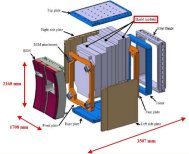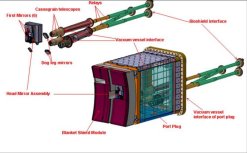The structure is organised along the following seven major topics (WP1-WP6)
| Work Programmes | |
| WP1 (CEA) | Nuclear Requirements in different phases from the engineering design to decommissioning |
| WP2 (CEA) | Maintainability associated to ITER Component Lifecycle |
| WP3 (KIT) | Materials, manufacturing and assembly of upper port plug structures |
| WP4 (KIT) | Design, manufacturing and integration of ITER relevant structural components |
| WP5 (HAS) | Thermomechanical Engineering of In-Vessel Components |
| WP6 (FZJ) | Feasibility of manufacturing in the design of ITER invessel components |
Host Association: CEA
Associations: KIT (FZK), FZJ, HAS, ITER IO
Companies/Industrials: AREVA TA (TBC)
Objectives
Most tokamak fusion devices that have been conceived throughout the world do not use Tritium for the fusion reaction. The ITER device (like JET) will operate D+T fusion, which will bring a new aspect to take into consideration for the conception of the whole machine:nuclear requirements through Tritium management and neutron and radiation shielding. The proposed training scheme is addressed to teach young engineers in order to give them the knowledge and the competence necessary to implement nuclear safety in projects for ITER. The aim of the training is to integrate the trainee in a project team for ITER Diagnostic port plug. He will be introduced to fusion and ITER, and will follow specific nuclear engineering courses and training sessions. The trainee will then take an active participation into the implementation of nuclear safety requirement (design, management, QA,documentation, manufacturing…) for the project.
Candidate and training profile:
This trainee will be a graduate mechanical engineer, preferably with good basic knowledge in the nuclear engineering field, with less than 4 years experience in research or science. The training activities will concentrate on the nuclear aspects of fusion and their impact on engineering activities during the whole project life. Moreover, this trainee will act in this training scheme as an expert on nuclear topics for the ITER Diagnostic port-plug project.
Description of Work
During the first two years of the training program, the trainee will be focused on courses and specialization on the scientific topic of the program (i.e. nuclear safety).The trainee will attend an important number of courses detailed below, and along the first two years.
Introductory courses - 3 months during the first year
-
Introduction to fusion physics and fusion technology.
-
Introduction to the design tools (especially Catia V5, ANSYS, etc.).
-
Introduction to ITER design (Assembly, remote handling…)
-
Introduction to Quality Assurance in nuclear engineering
Specific courses on generic issues - 3 months all along the project
-
Nuclear code and standards (RCC-MR, RCC-MX, ASME...).
-
Neutronics and radiation protection (ALARA).
-
Remote handling.
-
Vacuum technologies in nuclear environment.
-
Project management.
-
Procurement management with a focus on suppliers risk assessment.
-
Level 3 documents
Additional, missing skills should be added. The program will be flexible enough to adapt to the trainees specific abilities, wishes and the exact starting date of the training program. The trainee will apply these specific nuclear engineering methods in a CEA division specialized on these topics or in partnership with a firm specialized in nuclear engineering (such as AREVA TA).
Involvement in the ITER diagnostic port-plug project - 15 months
During the whole program, the trainee will be integrated in a project team. He will participate more and more actively to the ITER diagnostic port-plug 1 project, in order to apply his specific skills in nuclear engineering in the frame of the project. In particular, he will take part to these specific activities:
-
Neutronic and nuclear safety implementation.
-
Technical specification.
-
Management specification.
-
Development and sharing of the Level 3 documentation (codes and standards, regulation, technical operation rules…)
The trainee will spend about 30% of his time at the partner’s institutes. In particular, he will spend 3 months at FZK to work on neutronic aspects.
Manufacturing
issues - 15 months
The trainee will also take an active part in the implementation of nuclear safety requirements for manufacturing issues in the frame of the ITER equatorial port plug 1 project:
-
Prototyping.
-
Contracting.
-
Manufacturing follow-up issues with industrial suppliers.
Manufacturing follow-up for ITER prototypes or for Tore Supra components will possible depending on the actions in progress on those projects. The trainee will also spend three months at FZJ to work on manufacturing issues for CXRS diagnostic port plug inside the design team and in collaboration with industrial partners.
The goal of this training program is to allow the trainee to become more and more autonomous. He shall be able to take the lead in several tasks and manage them from the beginning to the end. Frequent discussions within the working group are foreseen to keep on track.
Host Association: CEA
Associations: HAS, KIT (FZK), ITER IO
Companies/Industrials: CYBERNETIX, MECACHIMIE, AREVA TA (TBC)
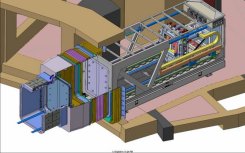
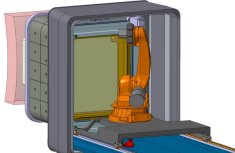
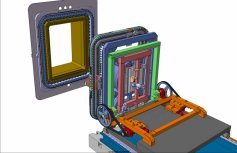
Objectives
The fusion reaction needs high magnetic fields, produces high energy neutron and generate very high temperatures. These severe conditions make first wall components highly constrained and causes its wear. Thus, many parts of this region must be replaced or refurbished during the reactor’s life.
The maintenance of a reactor in exploitation is a critical point, because it directly affects the availability of the machine and its economical productivity. Even if the goal of ITER is not to be an industrial reactor, it is essential to consider its maintainability for at least two major reasons: the first is to have powerful available experimental equipment, and the second is to demonstrate that the maintenance by remote handling is possible for the further steps.
In such a complex assembly, it is quite impossible to consider that all the parts are easily removable. Thus, it is necessary to preliminary identify what elements must replaced or refurbished and how often. Moreover, following the component location in the whole assembly, maintenance schemes must be clearly planned. In the case of a replacement, it is obviously necessary to handle the components, and in quite all cases of refurbishment, the operations are not made in-situ, but in Hot Cells. The logistic of this kind of facility must take into account the planned operations, but also the fact that some components could need to be replaced due to unexpected failure.
For a machine like ITER, the maintenance is a very hard challenge, due to its size and environment conditions. All the operation cannot be made hands-on because the level of radiation of the activated components is too high. This is especially true for the In-Vessel materials. This is the reason why the remote handling is one of the most important issues of the whole project. The maintenance, and especially the “remote maintenance” must be taken as design constraints, like those induced by the mechanical and thermal loads and the behaviour under magnetic field and inside vacuum.
Candidate and training profile:
This trainee will be a graduate mechanical engineer, preferably with good skills in maintenance processes, with less than 4 years experience in research or science. The candidate should gather enough knowledge to become an expert in the ITER Maintenance Plan mainly for the In-vessel elements (comprising all attached features ex-vessel).
As the thermonuclear reactor has to support ITER project scientific mission during a long period, it is necessary from the design phases to know about its lifecycle. All the phases of the components life (first testing, commissioning, first mounting on the VV, maintenance scheme, decommissioning, dismantling …) should be taken into account with a special care for the maintenance strategy that is strongly linked with the radiation levels (safety).
Description of Work
Training Step/Tasks/Duration
Introductory
courses - 3 months
-
Introduction to fusion physics and fusion technology.
-
Introduction to the design tools (especially Catia V5 DMU, ANSYS, etc.).
-
Introduction to ITER design (Assembly, remote handling…).
Specific courses on generic issues - 3 months
-
Maintenance in Nuclear Plants
-
Nuclear code and standards (RCC-MR, RCC-MX, ASME...).
-
Neutronics and radiation protection (ALARA).
-
Remote handling (possible interaction with PREFIT program).
-
Risk analysis (FMECA=Failure Modes, Effects and Critically Analysis).
-
Vacuum technologies in nuclear environment.
In order to complete the courses, the trainee could spend some time in French nuclear companies in order to:
-
be involved in maintenance of nuclear facilities (such as AREVA TA)
-
learn how to build remote intervention scenarios in irradiated environments (such as CYBERNETIX and/or MECACHIMIE)
R&D on the ITER port-plug engineering and integration - 12 months
The trainee will participate to the ITER port-plug engineering and integration projects (diagnostics, TBMs, ICRH antenna), in order to apply his specific skills in maintenance processes in the frame of the project. In particular, he will take part to these specific activities:
-
Technical specification.
-
Components design.
-
Remote Handling impact on design and maintainability.
Development of the port plugs maintenance strategies - 15 months
For each kind of port plug, their will be common maintenance aspects and specific activities.
The trainee (with the help of the port plugs expert) will identify and detail the operations and associated features:
-
Components Maintenance Procedure and Plan definition (hands-on and remote).
-
Hot Cells specific equipments. (catalogue of tools)
-
Standardization of maintenance assembly procedures.
-
Lifecycle of each kind of port plug
-
Evaluations of maintenance times
This development should be done with each partner’s involved in the program in order to take benefit of this time to try standardising the maintenance procedures:
-
2 months in FZK working on the TBM and ECRH:
-
prototypes/evaluation of joining techniques
-
assembly and acceptance test strategies
-
maintenance tools and remote handling
-
3 months in HAS working on:
-
assembly of diagnostics
-
DEMO divertor/blanket modules maintenance scheme
Host Association: KIT (FZK)
Associations: CEA, HAS
Companies / Industrials: Köppern GmbH, Brush-Wellman, Reuter GmbH
Universities: University Karlsruhe
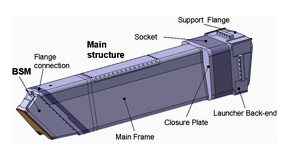
Objectives
The structural design of plasma facing components has to withstand severe conditions under normal operating conditions and especially during plasma disruptions: The challenging route from the CATIA drawings to an industrial manufacturing requires detailed knowledge of the used materials as well as suitable production techniques. Standardized assembly procedures and remote handling tools have to be developed in order to fulfil quality assurance needs and to guarantee fast assembly, delivery and installation on site. The trainee will work on fusion relevant systems (e.g. upper port plug for the ITER ECRH). He / she will obtain a broad knowledge of nuclear technology which will be developed further by active project participation in materials R&D and in engineering from the design to the final product.
Candidate
and training profile:
The candidate should be a graduate nuclear engineer, mechanical engineer or equivalent with basic knowledge of material properties and technology with less than 4 years of professional experience. The planned activities will offer the trainee an environment where he / she can gain experience towards engineering of large components with a specialization on fusion technology as well as on basic project management.
Description
of Work
Training Step/Tasks/Duration
Introductory phase - 3 months
-
Introduction to fusion physics and fusion technology.
-
Introduction to the design tools (especially Catia V5, ANSYS, etc.)
-
Introduction to upper port plug design, manufacturing and QA.
-
Introduction to assembly and acceptance test procedures.
-
Remote handling experiments.
Further courses (two course days per year) will be offered to develop the trainee’s skills e.g. on project management as well as the visit of one summer school organized by or in cooperation with FZK. The intercultural skills will mature by the integration in the international project team. Additional fusion oriented lectures including hands on experiments will give the trainee a broad base for future work in nuclear fusion.
Complementary training
Total duration of general project relevant courses is about 3 months. Location of the courses will be defined in detail.
-
Project management
-
Procurement management with focus on suppliers risk assessment
-
Level 3 documents
-
FTU offered trainings:
-
The Fundamentals of International Project Management
-
Leadership: Managing and Motivating Teams
-
Advanced International Project Management
-
Effective Negotiations
-
Coordination of Complex Projects
-
Risk Management in Projects
Involvement in the ITER upper port plug engineering - 18 months
The trainee will participate in engineering activities related to the design of large components for nuclear fusion technology with a focus on materials and manufacturing aspects.The fields of training will be:
-
Technical specifications.
-
Material specific component design.
-
Evaluation of manufacturing and joining technologies.
During this phase the trainee will spend about 30% of the time at the partners’ laboratories.
Involvement
in the ITER upper port plug assembly – 12 months
The trainee will participate in assembly studies for complex structural components. Practical experience will be made in the test facility for the upper port plug for ECRH in Karlsruhe.
The training will include:
-
Prototypes, maintenance tools and procedures.
-
Experimental studies at the Launcher Handling Test facility.
-
Component manufacturing and acceptance test issues with industrial suppliers.
-
Upper port assembly and final acceptance test issues.
During this phase the trainee will spend about 30% of the time at the partners’ laboratories. It is foreseen to exchange trainees with CEA (6 months) and HAS (3 months). During this exchange the FZK trainee will get a broad vision of port plug related activities in diagnostics, ICRH and specific remote handling techniques. The external trainees will participate in remote handling experiments and assembly studies for a large fusion component, the upper port plug for ECRH.
With the proposed activities the trainee will mature to a competent level that allows him / her to carry out procurement, testing and installation of large components for fusion technology.
Host Association: KIT (FZK)
Associations: CEA, HAS
Companies / Industrials: tbd
Universities: University Karlsruhe
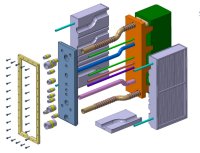
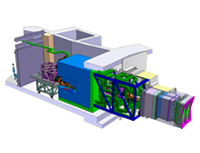
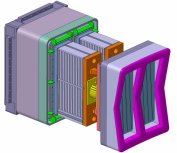
Objectives
At FZK, structural components are being developed for ITER port systems (e.g. TBM system development). The development of these components includes all steps from the CAD design, performance analyses (neutronic, mechanic and thermo-hydraulic) up to the preparation of manufacturing drawings. The validation of the design requires a complex testing program with the use of dedicated mock ups and test facilities. Manufacturing of mock ups and components requires close collaboration with industry including following up and assessment of the product.
The trainee will be integrated in a dedicated a project team and will obtain a broad knowledge of fusion relevant components and technology which will be developed further by active project participation from the design to the final product.
Candidate
and trainee profile
The trainee shall be graduate mechanical engineer. Basic knowledge in nuclear technology, manufacturing / welding processes would be an asset. The trainee will act during this program as an expert on engineering and design of port plug relevant components
Description
of work
Training steps
The program will be flexible enough to be adapted individually to the trainee specific abilities. The following list indicates educational options which will be selected according to the needs of the trainee and project specific requirements. Several courses and training phases will be selected from the ones listed below according to the education of the trainee. The total time frame for all trainings / courses during the whole trainee program is ~ 6 months.
Introductory courses
-
Total duration of introductory courses concerning engineering tools (CAD and FEM) is ~ 2 months
-
CATIA V5 basic training
-
CATIA V5 advanced training
-
PDM system SmarTeam
-
ANSYS (classic including workbench)
Project
relevant introduction
Total duration of project introductory courses is ~ 2 months, organized as courses or individual introductory lessons by tutors.
-
Introduction into fusion physics and technology
-
Introduction into quality assurance in nuclear engineering
-
Introduction into the TBM program (HCPB and HCLL concept)
-
Introduction into ITER systems design (e.g. integration and RH-systems and procedures, hot cell)
-
RCC-MR, RCC-MX, ASME…
-
Neutron and radiation protection (ALARA)
-
Vacuum technologies in nuclear environments
Complementary
training
Total duration of general project relevant courses is about 2 months. Location of the courses will be defined in detail.
-
Project management
-
Procurement management with focus on suppliers risk assessment
-
Level 3 documents
-
FTU offered trainings:
-
The Fundamentals of International Project Management
-
Leadership: Managing and Motivating Teams
-
Advanced International Project Management
-
Effective Negotiations
-
Coordination of Complex Projects
-
Risk Management in Projects
Project relevant meetings and conferences
The trainee will be involved in project relevant meetings and conferences (e.g. ISFNT, SOFT, SOFE, JKT). The total time for participation to project meetings and conferences can be estimated to ~ 2 month.
R&D
training Phase I: Design of ITER relevant
components
During phase I (duration ~9 months) of the project, the trainee will be involved in the ordinary technical work for development of ITER relevant components, e.g. in the Management Support & Design Integration (MDI) Team of the TBM Consortium located at FZK. During the initial phase, the trainee will be taught in CAD and analysis engineering tools. After the initial phase, the trainee will work out independently complete CAD designs of ITER relevant components. The design will be verified e.g. by mechanical, thermal and thermo-hydraulic or neutronic analysis at the end of phase I of the project. The following milestones can be defined for phase I of the trainee program:
-
Initial working phase, integration into engineering / collaboration MDI- team
-
Miscellaneous CAD- projects (tutorial)
-
Miscellaneous analysis (tutorial)
-
CAD design of structural components (preformed independently by the trainee)
-
Analysis of structural components (performed independently by the trainee)
R&D training Phase II: Procurement of mock ups
During the second phase, the trainee will be responsible for the procurement of a mock up corresponding to the design worked out during phase I. The duration of phase II can be estimated to ~9 moths. In the frame of this work, manufacturing processes (e.g. welding) will be investigated and verified (e.g. in collaboration with CEA Saclay, details tbd, and industrial companies). Appropriate manufacturers will be selected and benchmark-tests will be performed, e.g., by simple welding manufacturing process mock-ups which will be analysed.
Subsequently a manufacturer will be selected who is in charge of manufacturing of the integral mock-up. The manufacturing process will be supervised by the trainee, e.g. presence of the trainee during important manufacturing steps. At the end of phase II a mock-up of an ITER relevant component will be available. The following milestones can be defined during phase II of the project:
-
Selection of manufacturing process (collaboration with CEA Saclay, details tbd)
-
Pre-studies (material and process limits, in FZK and with CEA collaboration)
-
Selection of relevant welding parameters and geometries
-
Contact to relevant manufacturing companies
-
Design of welding manufacturing process mock-ups, follow-up during processing
-
Test of mock-up quality (e.g. Charpy tests, micro structure of Heat Affected Zone (HAZ))
-
Implementation of results in mock up design and manufacturing
-
Final design of fabrication mock-up, follow-up during processing
-
Procurement of mock-up from industry
-
Checking of mock up quality
R&D training Phase III: Planning / performance of experiments
In the frame of the 3 rd phase of the project (duration ~ 9 months) the trainee will be in charge to prepare and to supervise the experimental validation of the design worked out in phase I by the mock up procured in phase II. The experimental parameters will be defined by the trainee (e.g. thermal and structural loads on the mock up, coolant parameters, measurement principles and devices, measuring points) and installation of the required instrumentation will be prepared in collaboration with corresponding staff and followed up during processing. The performance of the dedicated experiments will be prepared in collaboration with the responsible staff members who are in charge to operate the test facility. The trainee will be present at the facility from the installation of the mock up into the facility and during the test operation of the mock up. Finally the test results will be interpreted for design verification.
The following milestones can be defined for the final phase of the trainee program:
-
Preparation of mock up
-
Definition of testing parameters
-
Definition of measured quantities and measurement points
-
Installation of diagnostic
-
Installation of heaters
-
Preparation of experiment
-
Negotiation with facility operating team
-
Design and manufacturing of test section for mock-up installation
-
Mock up installation into testing facility
-
participation / supervision during testing operation
-
Interpretation of experimental results for design verification
Host Association: HAS
Associations: CEA, KIT (FZK), ITER IO, + TBD
Companies / Industrials: TBD
Universities: Budapest University of Technology and Economics, TBD
Objectives
The significant thermal load requires efficient cooling in the in-vessel components of fusion devices. The plasma facing components, first walls and first mirrors need the most critical cooling system, because these are the most thermal loaded components, in addition the mostly eroded ones by neutron radiation, which effects shorter lifetime and more often maintenance and exchange interventions. Due to the strict vacuum circumstances the proper attachment principle of cooling supply pipes and channels are the welding, which can be done only as a remote handling operation during shutdown of fusion device and furthermore only in the hot cell. As it is high importance to keep the maintenance time acceptable short, complex, cooled, exchangeable modules are necessary to develop. During the different phases of design the satisfactory performance of cooling must be kept and checked by thermomechanical calculations.
The aim of this topic is to integrate the trainee in a project team for ITER Diagnostic port plugs. He/she will be introduced to fusion and ITER, and will follow specific thermomechanical engineering courses and training sessions. The trainee will then take an active participation into development of different diagnostic systems for ITER, accommodated in equatorial and upper port plugs (Bolometry, CXRS, LIDAR, Visible/IR Video, etc.)
Candidate
and training profile:
This trainee will be a graduate mechanical engineer, preferably with good basic knowledge in the fusion technology field, with less than 4 years experience in research or science. The training activities will concentrate on the thermal aspects of fusion and their impact on engineering activities during the whole project life. Moreover, this trainee will act in this training scheme as an expert on thermomechanical topics for the ITER Diagnostic port-plug project.
Description
of work
Training Step/Tasks/Duration
Introductory
courses - 3 months
-
Introduction to fusion physics and fusion technology.
-
Introduction to the CAD tools (especially Catia V5)
-
Introduction to ITER design (Assembly, remote handling…)
-
Introduction to Quality Assurance in nuclear engineering
Specific courses on generic issues - 9 months
-
Thermomechanical analyses tool (Ansys)
-
Computational Fluid Dynamics
-
Remote handling
-
Vacuum technologies
-
Project management
-
Procurement management with a focus on suppliers risk assessment
-
TCWS, HCS (Cooling systems of ITER and EU-TBMs)
Additional, missing skills should be added. The program will be flexible enough to adapt to the trainees specific abilities, wishes and the exact starting date of the training program.
The trainee will acquire these specific thermomechanical engineering methods in the organisation of EURATOM-HAS involving plasma physics and fusion technology specialist institute (KFKI-RMKI) and two departments (MM, NTI) of Budapest University of Technology and Economics, as well as proper industrial companies having the relevant manufacturing technologies.
Involvement
in the ITER diagnostic port-plug project – 20
months
The trainee will participate more and more actively to the ITER diagnostic port-plug projects, in order to apply his specific skills in thermomechanical engineering in the frame of the project. In particular, he will take part in these specific activities:
-
Technical specification
-
Components design
-
Thermomechanical analyses
-
Tests on different facilities
The trainee will spend about 30% of his time at the partner’s institutes.
Visitation
of collaborator institutes
-
4 months in CEA-Cadarache:
The trainee will join to ongoing development of ITER Port Plugs and will take part in the thermomechanical calculations and analyses. He/she will be involved in technical discussions between CEA and ITER IO staff. He/she will investigate the thermomechanical experiments of Tore Supra.
-
3 months in FZK:
The trainee will be involved in the ongoing experiments and development of HELOKA and MEKKA. He/she will take part in the thermomechanical analyses of HCPB-TBM and components of ITER Upper Port (ECRH). (Under confirmation process)
-
2 months in FZJ:
The trainee will be temporarily integrated in a project team for the ITER CXRS diagnostic port plug and his/her activity will focus on the thermomechanical issues. (Under confirmation process)
Manufacturing
issues - 4 months
-
Mock-up manufacturing
-
Manufacturing follow-up issues with industrial suppliers
The goal of this training program is to allow the trainee to become more and more autonomous. He shall be able to take the lead in several tasks and manage them from the beginning to the end. Frequent discussions within the working group are foreseen to keep on track.
Host Association: FZJ
Associates: CEA, KIT (FZK), ITER IO
Companies / Industrials: AREVA NP
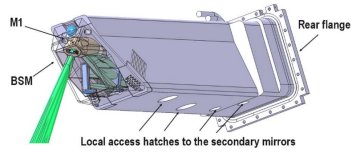
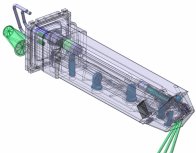
Objectives:
Design activities for ITER in vessel components usually start with general concept studies followed by several analysis steps. What comes last in the process is the consideration of boundary conditions defined by possible manufacturing processes. The proposed training is to qualify a young engineer in order to give him the knowledge and the competence necessary to take into account the feasibility of manufacturing in the design process in projects for ITER.
The aim of the training is to integrate the trainee in a project team for the ITER CXRS diagnostic port plug. He will be introduced to fusion, ITER, and diagnostic systems. Within the project team he will gain specific knowledge on the engineering of an ITER diagnostic port plug. The trainee will be involved in the supervision of contracts with industry aiming at concept development, engineering analysis, prototype manufacturing, and testing.
Candidate
and training profile:
The trainee will be a graduate mechanical engineer, preferably with good basic knowledge in the nuclear engineering field, with less than 4 years experience in research or science. The training activities will concentrate on the manufacturing aspects in the in vessel component design process.
Description
of work
Training Step/Tasks/Duration
Introductory courses - 2 months
-
Introduction to fusion physics and fusion technology,
-
Introduction to engineering of tokamak in-vessel components,
-
Introduction to the design tools (especially CATIA V5, ANSYS, etc.),
-
Introduction to ITER design (assembly, remote handling…).
Specific courses on generic issues - 2 months
-
ITER diagnostics,
-
Tokamak engineering,
-
Remote handling,
-
Vacuum technologies,
-
Project management.
Specific training in industry (with ENSA, TBC) - 5 months
-
Manufacturing issues,
-
Project management,
-
QA.
Specific training at other EURATOM Associations- 4 months
-
CEA: training on relevant aspects of the CEA ITER diagnostic port plug project,
-
FZK: training on relevant aspects of the FZK ITER diagnostic port plug projects.
Additional, missing skills should be added. The program will be flexible enough to adapt to the trainees specific abilities, wishes and the exact starting date of the training program.
Involvement
in the ITER CXRS diagnostic port plug project -
23 months
The trainee will participate more and more actively in the ITER CXRS diagnostic port plug project, in order to apply his specific skills in manufacturing considerations in the frame of the project. In particular, he will take part to these specific activities:
-
Detailed design of retractable tube, mirror mounts, shutter.
-
Engineering analysis of listed components
-
Supervision of industry contracts.
-
Prototyping.
-
Manufacturing follow-up issues with industrial suppliers.

